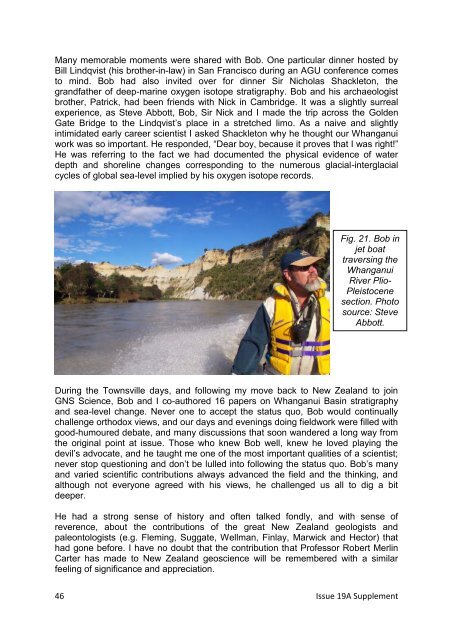Remembering Bob Carter A GSNZ Tribute
GSNZ%20Newsletter%2019A%20July%202016
GSNZ%20Newsletter%2019A%20July%202016
Create successful ePaper yourself
Turn your PDF publications into a flip-book with our unique Google optimized e-Paper software.
Many memorable moments were shared with <strong>Bob</strong>. One particular dinner hosted by<br />
Bill Lindqvist (his brother-in-law) in San Francisco during an AGU conference comes<br />
to mind. <strong>Bob</strong> had also invited over for dinner Sir Nicholas Shackleton, the<br />
grandfather of deep-marine oxygen isotope stratigraphy. <strong>Bob</strong> and his archaeologist<br />
brother, Patrick, had been friends with Nick in Cambridge. It was a slightly surreal<br />
experience, as Steve Abbott, <strong>Bob</strong>, Sir Nick and I made the trip across the Golden<br />
Gate Bridge to the Lindqvist’s place in a stretched limo. As a naive and slightly<br />
intimidated early career scientist I asked Shackleton why he thought our Whanganui<br />
work was so important. He responded, “Dear boy, because it proves that I was right!”<br />
He was referring to the fact we had documented the physical evidence of water<br />
depth and shoreline changes corresponding to the numerous glacial-interglacial<br />
cycles of global sea-level implied by his oxygen isotope records.<br />
Fig. 21. <strong>Bob</strong> in<br />
jet boat<br />
traversing the<br />
Whanganui<br />
River Plio-<br />
Pleistocene<br />
section. Photo<br />
source: Steve<br />
Abbott.<br />
During the Townsville days, and following my move back to New Zealand to join<br />
GNS Science, <strong>Bob</strong> and I co-authored 16 papers on Whanganui Basin stratigraphy<br />
and sea-level change. Never one to accept the status quo, <strong>Bob</strong> would continually<br />
challenge orthodox views, and our days and evenings doing fieldwork were filled with<br />
good-humoured debate, and many discussions that soon wandered a long way from<br />
the original point at issue. Those who knew <strong>Bob</strong> well, knew he loved playing the<br />
devil’s advocate, and he taught me one of the most important qualities of a scientist;<br />
never stop questioning and don’t be lulled into following the status quo. <strong>Bob</strong>’s many<br />
and varied scientific contributions always advanced the field and the thinking, and<br />
although not everyone agreed with his views, he challenged us all to dig a bit<br />
deeper.<br />
He had a strong sense of history and often talked fondly, and with sense of<br />
reverence, about the contributions of the great New Zealand geologists and<br />
paleontologists (e.g. Fleming, Suggate, Wellman, Finlay, Marwick and Hector) that<br />
had gone before. I have no doubt that the contribution that Professor Robert Merlin<br />
<strong>Carter</strong> has made to New Zealand geoscience will be remembered with a similar<br />
feeling of significance and appreciation.<br />
46 Issue 19A Supplement


